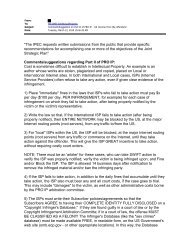We Energies Coal Combustion Products ... - The White House
We Energies Coal Combustion Products ... - The White House
We Energies Coal Combustion Products ... - The White House
Create successful ePaper yourself
Turn your PDF publications into a flip-book with our unique Google optimized e-Paper software.
A person drinking the recommended 8 glasses of water a day would<br />
consume about 10 pCi of radium per day, of which about 30% would be<br />
absorbed into the body (International Commission on Radiation Protection,<br />
Report of Committee 2, 1963). <strong>The</strong> food highest in radium is the Brazil nut.<br />
Brazil nuts selectively concentrate calcium family elements such as barium<br />
and radium (R. L. Kathren, 1984, Radioactivity in the Environment, Harwood<br />
Academic Publishers, p. 67). This concentration process gives Brazil nuts a<br />
radium concentration of 1-7 pCi per gram or, in a comparison to water on a<br />
weight basis, 1000 – 7000 pCi per liter. All other foods contain, on average,<br />
1/1000 th of the radium found in Brazil nuts. <strong>The</strong> US Nuclear Regulatory<br />
Commission sets the annual ingestion limit for Ra-226 at 2,000,000 pCi/yr<br />
(Title 10, Code of Federal Regulations, Part 20, Appendix B).<br />
L. Radon, a chemically inert, radioactive gas produced by the decay of radium,<br />
is a normal constituent of air and enters the body by breathing. Radon<br />
generated by the decay of radium diffuses into the soil pore water where it<br />
can reach concentrations of 100 – 1000 pCi/liter. <strong>The</strong> pore water radon then<br />
diffuses out of the ground into the air to yield concentrations on the order 0.1<br />
– 0.2 pCi/liter in the northern hemisphere (NCRP Report No. 94). <strong>The</strong><br />
amount and rate of radon entering the air from the ground depends not only<br />
upon the amount of radium in the soil but also on the physical condition of<br />
the soil containing the radium. Frozen soil and snow cover slow down the<br />
transfer of radon to the air. Radon diffuses out of porous soils more quickly<br />
than out of rock or compacted soil. Meteorological conditions like wind speed<br />
and the air pressure also affect the transfer of radon from the soil to the air.<br />
Unlike the other elements, radon does not react chemically with the body and<br />
so is readily exhaled as well as inhaled. <strong>The</strong> concentration of radon in our<br />
lungs is normally in equilibrium with the concentration in the air that we<br />
breathe.<br />
M. <strong>The</strong> energy released by radioactive elements can be measured. <strong>The</strong> amount<br />
of energy deposited in the human body from radioactive decay is called<br />
dose. As mentioned above, radionuclides enter the body through air and<br />
foods we eat. Energy deposited in our bodies from the radioactive isotopes<br />
in our bodies is called internal dose. External doses result from gamma rays<br />
emitted by terrestrial NORM sources such as the ground and building<br />
materials and from cosmic rays. Roughly 1,000,000 photons per minute are<br />
responsible for the terrestrial component of the total NORM dose. About<br />
500,000 decays per minute in our bodies contribute to our internal NORM<br />
dose (M. Eisenbud, Environment Vol.26 (10): 6-33, 1984). This internal<br />
NORM acts as an external radiation source to people around us. Based on<br />
the amount of K-40, the standard 154-pound adult emits about 24,400<br />
photons per minute, which contributes dose to nearby individuals.<br />
N. <strong>The</strong> standard dose unit in the United States is the rem. Because doses from<br />
NORM are small, these doses are reported in millirem (mrem), or 1/1000 th of<br />
a rem. In the US, the average annual NORM dose is 300 mrem. <strong>The</strong> largest<br />
part of this dose, 200 mrem, comes from the radon in the air. When we say<br />
the dose is from the radon in air, this actually is shorthand for radon and the<br />
radionuclides to which the radon decays. It is the decay products that<br />
produce most of the dose because these decay products, as opposed to a<br />
noble gas, are particulates that remain in the lungs for a longer period of<br />
time. Two of these decay products, lead-210 (22.3 yr half-life) and polonium-<br />
210 (138 day half-life) contribute most of the dose. <strong>The</strong> remaining 100 mrem<br />
<strong>We</strong> <strong>Energies</strong> 270<br />
<strong>Coal</strong> <strong>Combustion</strong> <strong>Products</strong><br />
Utilization Handbook



